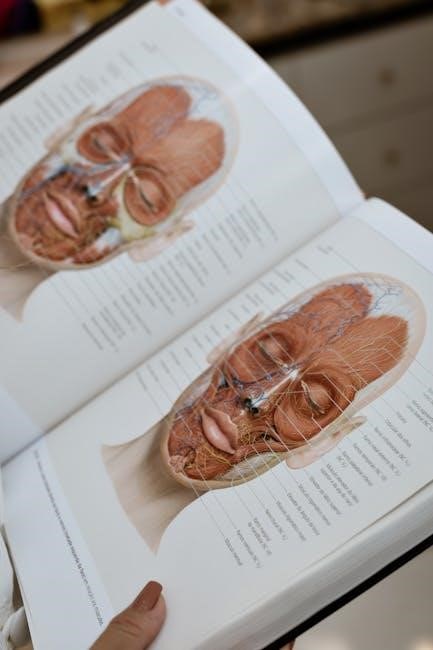Overview of the Lindeburg PE Reference Manual
The Lindeburg PE Reference Manual is a comprehensive guide for engineering exam preparation, authored by Michael R. Lindeburg and published by Professional Publications, Inc. It offers detailed coverage of various engineering disciplines, including environmental, civil, mechanical, and electrical engineering, with practice problems and solutions. The manual is widely recognized for its authoritative content and is regularly updated to align with exam requirements, making it an essential resource for PE exam candidates.

1.1. History and Evolution of the Manual
The Lindeburg PE Reference Manual, authored by Michael R. Lindeburg, P.E., has a rich history dating back to its first publication. Initially designed to address the growing need for comprehensive exam preparation resources, the manual quickly became a cornerstone for engineering professionals. Over the years, it has evolved to cover a wide range of engineering disciplines, including environmental, civil, mechanical, and electrical engineering. The manual’s content has been refined through multiple editions, with updates reflecting changes in exam formats and engineering standards. Notable milestones include the addition of environmental engineering topics in 2003 and the expansion of practice problems for civil engineering in its 11th edition. This continuous improvement ensures the manual remains a vital tool for PE exam candidates, adapting to their needs and the industry’s advancements.
1.2. Purpose and Scope of the Reference Manual
The Lindeburg PE Reference Manual is specifically designed to assist engineering professionals in preparing for the Principles and Practice of Engineering (PE) exam. Its primary purpose is to provide a comprehensive, one-stop reference that covers the breadth of topics typically tested on the exam. The manual’s scope is broad, encompassing key subjects such as environmental engineering, civil engineering, and mechanical engineering, ensuring candidates are well-prepared across all exam areas. It includes detailed explanations, practice problems, and solutions to help deepen understanding and improve problem-solving skills. Regular updates ensure the content aligns with current exam standards and industry practices. By focusing on clarity and depth, the manual serves as an indispensable tool for PE exam candidates, helping them build confidence and competence for success.
1.3. Target Audience for the Manual
The Lindeburg PE Reference Manual is primarily intended for engineering professionals preparing for the Principles and Practice of Engineering (PE) exam. It is particularly useful for civil, environmental, mechanical, and electrical engineers seeking to advance their careers through licensure. The manual is also beneficial for recent engineering graduates and practicing engineers who need a comprehensive review of fundamental concepts and advanced topics. Additionally, educators and trainers in engineering fields may find the manual a valuable resource for curriculum development and teaching. Its clear explanations and practice problems make it accessible to a wide range of learners, from those early in their careers to experienced professionals needing a refresher. The manual’s broad scope ensures it serves as both a study guide and a long-term reference for engineering professionals.

1.4. Structure and Organization of the Manual
The Lindeburg PE Reference Manual is meticulously organized to facilitate effective learning and exam preparation. It typically begins with an overview of the exam format and content, followed by detailed chapters covering fundamental engineering principles. Each chapter is structured to build upon previous knowledge, starting with basic concepts and progressing to advanced topics. The manual is divided into sections corresponding to specific engineering disciplines, such as civil, environmental, mechanical, and electrical engineering, ensuring focused study. Practice problems and solutions are interspersed throughout, often at the end of chapters, to reinforce understanding. Additionally, the manual includes appendices with essential formulas, charts, and references, making it a comprehensive and accessible resource. This logical structure allows users to navigate the content seamlessly, whether they are studying a particular subject or preparing for the exam holistically.

Exam Preparation with the Lindeburg PE Reference Manual
The manual provides comprehensive study strategies, practice problems with solutions, and covers key exam topics, helping candidates build a strong foundation and manage their time more effectively.
2.1. Study Strategies for the PE Exam
The Lindeburg PE Reference Manual provides effective study strategies to help candidates prepare for the exam systematically. It emphasizes understanding the exam format, managing time, and focusing on high-probability topics. The manual offers structured approaches to tackle complex problems, ensuring a logical progression from basic concepts to advanced applications. Additionally, it encourages the use of practice problems to identify weak areas and improve problem-solving skills. By following the manual’s strategies, candidates can develop a balanced study plan that covers all essential topics efficiently. The guide also stresses the importance of regular practice and review to reinforce knowledge retention. Overall, the manual serves as a roadmap, guiding candidates through their preparation journey with clarity and precision.
2.2. Practice Problems and Solutions
The Lindeburg PE Reference Manual includes an extensive collection of practice problems and solutions, designed to simulate actual exam conditions. These problems cover a wide range of topics and are structured to test both theoretical knowledge and practical application; Each problem is accompanied by detailed step-by-step solutions, enabling candidates to understand the thought process behind each answer. This feature allows learners to identify gaps in their knowledge and refine their problem-solving techniques. The manual also provides explanations for common mistakes, helping candidates avoid errors during the exam. The practice problems are categorized by difficulty, ensuring a gradual progression from basic to advanced levels. This comprehensive approach makes the manual an invaluable tool for candidates aiming to master the exam material effectively.
2.3. Key Topics Covered in the Manual
The Lindeburg PE Reference Manual covers a broad range of engineering topics essential for the PE exam. It includes detailed sections on environmental engineering, such as water treatment, air quality, and waste management. Civil engineering topics encompass structural analysis, transportation, and geotechnical engineering. Mechanical engineering chapters focus on thermodynamics, fluid mechanics, and heat transfer. Electrical engineering sections address circuits, power systems, and electronics. The manual also includes chemical engineering principles, such as process design and chemical reactions. Each topic is presented with clear explanations, equations, and diagrams, ensuring a thorough understanding. Practice problems and solutions are integrated to reinforce learning. The manual’s comprehensive coverage makes it a one-stop resource for PE exam preparation, providing candidates with the knowledge and tools needed to succeed.
2.4. Time Management Techniques for Exam Preparation

The Lindeburg PE Reference Manual emphasizes effective time management to help candidates optimize their study schedule; It suggests prioritizing key topics and allocating specific time frames for each subject. The manual includes practice exams with timed conditions, simulating real exam scenarios to improve pacing. Candidates are advised to dedicate equal time to both studying and practicing problems. Additionally, the manual recommends creating a detailed study plan, focusing on weak areas first, and regularly reviewing progress. By mastering these techniques, candidates can efficiently cover the syllabus and perform confidently during the actual exam. The manual’s structured approach ensures that time is utilized wisely, balancing preparation with practice to enhance overall readiness.

Subject-Specific Chapters in the Manual
The manual features dedicated chapters for Environmental, Civil, Mechanical, and Electrical Engineering, each providing in-depth coverage of core concepts, practical applications, and exam-relevant topics essential for comprehensive preparation.
3.1. Environmental Engineering
The Environmental Engineering chapter in the Lindeburg PE Reference Manual provides a thorough review of key topics such as water treatment, wastewater management, air quality control, and solid waste management. It includes detailed explanations of environmental regulations and sustainability practices, ensuring candidates are well-prepared for exam questions related to environmental systems and processes. The chapter also covers fundamental concepts like hydrology, water resources, and environmental chemistry, with practical examples and case studies to aid understanding. Additionally, it addresses emerging topics such as climate change mitigation and green engineering practices, aligning with current industry standards and exam requirements. This section is designed to help engineers apply theoretical knowledge to real-world problems, making it an invaluable resource for the PE exam.
3.2. Civil Engineering
The Civil Engineering section of the Lindeburg PE Reference Manual is a comprehensive resource for exam preparation, covering essential topics such as structural analysis, transportation engineering, geotechnical engineering, water resources, and construction management. The chapter provides in-depth explanations of fundamental concepts and practical applications, supported by equations, diagrams, and examples. It also includes practice problems and solutions to help candidates assess their understanding of key civil engineering principles. The manual emphasizes alignment with the NCEES exam format, ensuring relevance and effectiveness. Topics such as beam design, soil mechanics, and hydrology are thoroughly addressed, along with real-world case studies and modern engineering practices. This section is designed to equip civil engineering candidates with the knowledge and problem-solving skills necessary to excel on the PE exam.
3.3. Mechanical Engineering
The Mechanical Engineering section of the Lindeburg PE Reference Manual provides a detailed review of core mechanical engineering topics, essential for the PE exam. It covers thermodynamics, mechanics of materials, fluid mechanics, heat transfer, and mechanical systems design. The chapter includes practical examples, equations, and diagrams to illustrate key concepts, such as energy conversion, stress-strain relationships, and fluid flow dynamics. Practice problems and solutions are integrated throughout to reinforce learning and assess understanding. The manual also addresses emerging topics in mechanical engineering, ensuring candidates are prepared for modern challenges. By focusing on both theoretical foundations and practical applications, this section helps mechanical engineering candidates build the expertise needed to succeed on the PE exam, aligning closely with NCEES content specifications.
3.4. Electrical Engineering
The Electrical Engineering chapter in the Lindeburg PE Reference Manual provides a thorough review of fundamental and advanced topics, including circuit analysis, power systems, electronics, and electromagnetism. It covers essential concepts such as AC/DC circuits, transformers, and power distribution, with detailed formulas and diagrams to aid understanding. The section emphasizes practical applications relevant to the PE exam, such as motor control systems, signal processing, and electrical safety standards. Practice problems and solutions are included to help candidates assess their knowledge and improve problem-solving skills. The manual also addresses emerging technologies in electrical engineering, ensuring candidates are well-prepared for modern challenges. By combining theoretical foundations with real-world examples, this chapter equips electrical engineering candidates with the tools needed to excel on the PE exam, aligning closely with NCEES specifications.
3.5. Chemical Engineering
The Chemical Engineering section of the Lindeburg PE Reference Manual is designed to provide a comprehensive review of key concepts and principles essential for the PE exam. It covers fundamental topics such as thermodynamics, fluid mechanics, mass transfer, and reaction engineering, with detailed explanations and examples. The chapter emphasizes practical applications, including process design, chemical kinetics, and material balances, aligning closely with the NCEES exam specifications. Practice problems and solutions are incorporated to help candidates assess their understanding and improve problem-solving skills. Additionally, the manual addresses emerging topics in chemical engineering, ensuring candidates are well-prepared for modern challenges. By focusing on both theoretical knowledge and real-world applications, this section equips chemical engineering candidates with the tools needed to excel on the PE exam. It serves as a valuable resource for both review and advanced study.

Supplementary Resources and References
The Lindeburg PE Reference Manual is complemented by online resources, additional practice exams, and references for advanced study, enhancing exam preparation and providing a comprehensive learning experience.
4.1. Online Resources and Tools
The Lindeburg PE Reference Manual is supported by a variety of online resources and tools designed to enhance exam preparation. These include practice exams, video tutorials, and interactive calculators that provide candidates with additional ways to master the material. Many of these resources are accessible through the publisher’s website, allowing users to practice problems, review solutions, and access study guides remotely. The online tools are particularly useful for candidates who prefer interactive learning or need flexibility in their study schedule. Additionally, some resources offer real-time feedback, enabling users to identify and address weaknesses in their knowledge. These online supplements are designed to complement the manual, ensuring a well-rounded and effective study experience for PE exam candidates. By leveraging these tools, individuals can optimize their preparation and improve their chances of success on the exam.
4.2. Additional Practice Exams
The Lindeburg PE Reference Manual is complemented by additional practice exams that are available for candidates to test their knowledge and readiness. These exams are designed to simulate the actual PE exam experience, offering a realistic format and difficulty level. They cover a wide range of engineering topics, ensuring that candidates are well-prepared across all subject areas. The practice exams include multiple-choice questions, solved problems, and comprehensive solutions, allowing users to assess their understanding and identify areas for improvement. Many of these exams are discipline-specific, such as environmental or civil engineering, enabling focused study. The exams are updated regularly to reflect changes in the PE exam format and content, ensuring relevance and accuracy. By utilizing these additional practice exams, candidates can refine their test-taking strategies and build confidence before the actual exam. This resource is invaluable for thorough and effective preparation.
4.3. References for Advanced Study
The Lindeburg PE Reference Manual includes a comprehensive list of references for advanced study, designed to support candidates in deepening their knowledge in specialized areas. These references are carefully curated to provide additional resources for topics covered in the manual, ensuring a thorough understanding of complex engineering concepts. The manual directs users to authoritative textbooks, industry standards, and research papers that are essential for advanced preparation. Many of these references are discipline-specific, catering to the unique needs of environmental, civil, mechanical, and electrical engineers. Additionally, the manual highlights online resources such as academic journals and professional publications, offering access to the latest developments in engineering fields. These references are invaluable for candidates who wish to explore topics in greater detail or require supplementary materials to strengthen their exam readiness. They serve as a bridge between the manual and real-world engineering challenges, enhancing overall preparation and confidence.

The Importance of the Lindeburg PE Reference Manual in Exam Preparation
The Lindeburg PE Reference Manual is a cornerstone for exam preparation, offering a comprehensive and authoritative guide that aligns with exam requirements, ensuring candidates are well-equipped for success.

5.1. Why It Is a Must-Have for PE Exam Candidates
The Lindeburg PE Reference Manual is indispensable for exam candidates due to its comprehensive coverage of engineering topics and practice problems. It provides detailed explanations and solutions, helping candidates understand complex concepts. The manual is regularly updated to reflect current exam content, ensuring relevance and accuracy. Its structured approach allows candidates to identify weak areas and focus their study efforts effectively. Additionally, the inclusion of multiple engineering disciplines makes it a versatile resource for candidates from various backgrounds. The manual’s reputation as a trusted study aid has made it a cornerstone for successful exam preparation, offering both theoretical knowledge and practical application. Its availability in updated editions further solidifies its importance as a essential tool for achieving licensure.
5.2. Tips for Effective Use of the Manual
To maximize the benefits of the Lindeburg PE Reference Manual, candidates should create a structured study plan, prioritizing key topics and allocating sufficient time for each section. Regularly reviewing notes and summaries can reinforce understanding; Integrating practice problems into daily study routines helps build problem-solving skills and familiarity with exam formats. Time management is crucial; dedicate specific hours to studying and reviewing to maintain consistency. Additionally, candidates should use the manual in conjunction with online resources and practice exams for a well-rounded preparation. Regularly reviewing difficult topics and seeking clarification when needed ensures a strong foundation. By adopting a systematic approach and maintaining discipline, candidates can effectively utilize the manual to achieve their exam goals. Consistency and focus are key to leveraging this valuable resource for successful licensure.

Recent Updates and Editions
The Lindeburg PE Reference Manual is regularly updated to reflect current exam requirements, ensuring relevancy and accuracy. New editions include expanded chapters on emerging topics like environmental engineering, enhancing its comprehensiveness for candidates.
6.1. What’s New in the Latest Edition
The latest edition of the Lindeburg PE Reference Manual includes updated chapters reflecting current engineering standards and practices. New sections focus on emerging topics such as sustainability and advanced environmental engineering. The manual now features expanded practice problems with detailed solutions, mirroring recent exam formats. Additionally, the latest version incorporates feedback from previous users, enhancing clarity and accessibility. The updates ensure candidates are well-prepared for the evolving nature of the PE exam, covering the latest developments in civil, mechanical, and electrical engineering. The revised content aligns with the National Council of Examiners for Engineering and Surveying (NCEES) guidelines, making it a reliable resource for exam success. This edition solidifies the manual’s reputation as a leading study guide for PE exam candidates.
6.2. Relevance of Updates to the PE Exam
The updates in the latest edition of the Lindeburg PE Reference Manual are closely aligned with the current requirements of the PE exam. The revisions reflect changes in engineering standards, codes, and practices, ensuring candidates are prepared for the most relevant topics. The inclusion of new practice problems mirrors recent exam formats, helping users familiarize themselves with question types and difficulty levels. The emphasis on sustainability and emerging technologies addresses modern engineering challenges, which are increasingly covered in the exam. Additionally, the manual’s alignment with the National Council of Examiners for Engineering and Surveying (NCEES) guidelines ensures that candidates receive accurate and up-to-date information. These updates enhance the manual’s effectiveness as a primary study resource, making it indispensable for achieving success on the PE exam.
